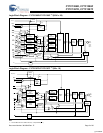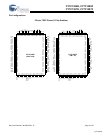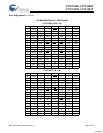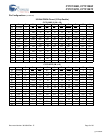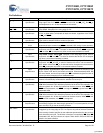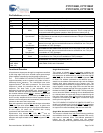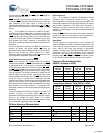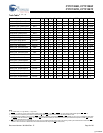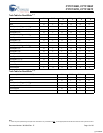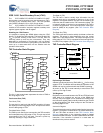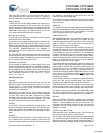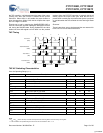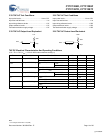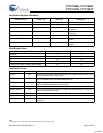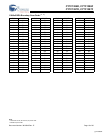
CY7C1386D, CY7C1386F
CY7C1387D, CY7C1387F
Document Number: 38-05545 Rev. *E Page 7 of 30
Functional Overview
All synchronous inputs pass through input registers controlled
by the rising edge of the clock. All data outputs pass through
output registers controlled by the rising edge of the clock.
The CY7C1386D/CY7C1387D/CY7C1386F/CY7C1387F
supports secondary cache in systems using either a linear or
interleaved burst sequence. The interleaved burst order
supports Pentium
®
and i486™ processors. The linear burst
sequence is suited for processors that use a linear burst
sequence. The burst order is user selectable, and is
determined by sampling the MODE input. Accesses can
be
initiated with either the processor address strobe (ADSP)
or
the controller address strobe (ADSC
). Address advancement
through the burst sequence is controlled by the ADV
input. A
two-bit on-chip wraparound burst counter captures the first
address in a burst sequence and automatically increments the
address for the rest of the burst access.
Byte write operations are qualified with the byte write enable
(BWE
) and byte write select (BW
X
) inputs. A global write
enable (GW
) overrides all byte write inputs and writes data to
all four bytes. All writes are simplified with on-chip
synchronous self timed write circuitry.
Synchronous chip selects CE
1
, CE
2
, CE
3
[2]
and an
asynchronous output enable (OE
) provide for easy bank
selection and
output tri-state control.
ADSP
is ignored if
CE
1
is HIGH.
Single Read Accesses
This access is initiated when the following conditions are
satisfied at clock rise: (1) ADSP
or ADSC is asserted LOW, (2)
chip selects are all asserted active, and (3) the write signals
(GW, BWE) are all deasserted HIGH. ADSP is ignored if CE
1
is HIGH. The address presented to the address inputs is
stored into the address advancement logic and the address
register while being presented to the memory core. The
corresponding data is allowed to propagate to the input of the
output registers. At the rising edge of the next clock the data
is allowed to propagate through the output register and onto
the data bus within t
CO
if OE is active LOW. The only exception
occurs when the SRAM is emerging from a deselected state
to a selected state, its outputs are always tri-stated during the
first cycle of the access. After the first cycle of the access, the
outputs are controlled by the OE
signal. Consecutive single
read cycles are supported.
The CY7C1386D/CY7C1387D/CY7C1386F/CY7C1387F is a
double cycle deselect part. Once the SRAM is deselected at
clock rise by the chip select and either ADSP
or ADSC signals,
its output will tri-state immediately after the next clock rise.
Single Write Accesses Initiated by ADSP
This access is initiated when both of the following conditions
are satisfied at clock rise: (1) ADSP
is asserted LOW, and (2)
chip select is asserted active. The address presented is
loaded into the address register and the address
advancement logic while being delivered to the memory core.
V
SS
Ground Ground for the core of the device.
V
SSQ
IO Ground Ground for the IO circuitry.
V
DDQ
IO Power Supply Power supply for the IO circuitry.
MODE Input-
Static
Selects burst order. When tied to GND selects linear burst sequence. When tied
to V
DD
or left floating selects interleaved burst sequence. This is a strap pin and
must remain static during device operation. Mode pin has an internal pull up.
TDO JTAG serial output
Synchronous
Serial data-out to the JTAG circuit. Delivers data on the negative edge of TCK. If
the JTAG feature is not used, this pin must be disconnected. This pin is not available
on TQFP packages.
TDI JTAG serial
input
Synchronous
Serial data-in to the JTAG circuit. Sampled on the rising edge of TCK. If the JTAG
feature is not used, this pin can be disconnected or connected to V
DD
. This pin is
not available on TQFP packages.
TMS JTAG serial
input
Synchronous
Serial data-in to the JTAG circuit. Sampled on the rising edge of TCK. If the JTAG
feature is not used, this pin can be disconnected or connected to V
DD
. This pin is
not available on TQFP packages.
TCK JTAG-
Clock
Clock input to the JTAG circuitry. If the JTAG feature is not used, this pin must
be connected to V
SS
. This pin is not available on TQFP packages.
NC – No Connects. Not internally connected to the die
NC/(36M, 72M,
144M, 288M,
576M, 1G)
– These pins are not connected. They will be used for expansion to the 36M, 72M,
144M, 288M, 576M, and 1G densities.
Pin Definitions (continued)
Name IO Description
[+] Feedback




